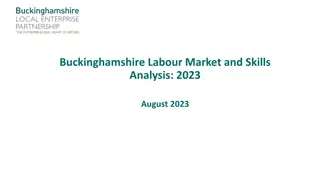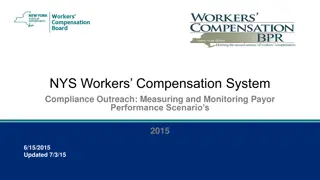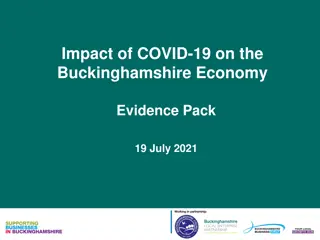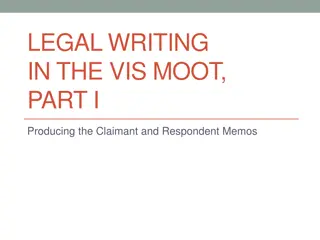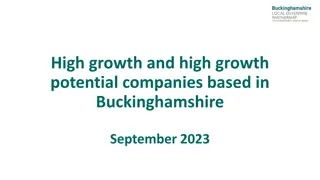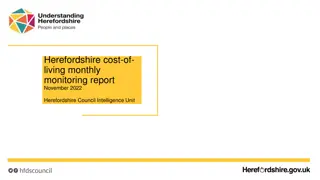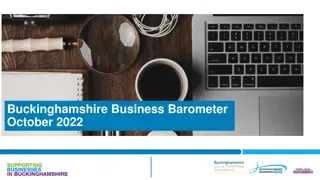Buckinghamshire Claimant Count Analysis - June 2023
This report provides a detailed analysis of the Buckinghamshire Claimant Count for June 2023, highlighting key statistics such as the total number of claimants, changes from previous months, claimant rates, and comparisons to national averages. The data presented sheds light on the impact of the Covid-19 pandemic on out-of-work benefits in Buckinghamshire.
Download Presentation

Please find below an Image/Link to download the presentation.
The content on the website is provided AS IS for your information and personal use only. It may not be sold, licensed, or shared on other websites without obtaining consent from the author.If you encounter any issues during the download, it is possible that the publisher has removed the file from their server.
You are allowed to download the files provided on this website for personal or commercial use, subject to the condition that they are used lawfully. All files are the property of their respective owners.
The content on the website is provided AS IS for your information and personal use only. It may not be sold, licensed, or shared on other websites without obtaining consent from the author.
E N D
Presentation Transcript
Buckinghamshires Claimant Count Buckinghamshire s Claimant Count July 2023
Background Background This report provides a monthly summary of the number of Buckinghamshire residents claiming out-of-work related benefits (the Claimant Count). Data is sourced from the Department for Work and Pensions (DWP) and can be found on the NOMIS website. A full explanation of the measure can be found in the Technical Appendix at the end of this report.
Headlines June 2023 In June 2023, 8,870 Buckinghamshire residents were claiming out-of-work related benefits (the Claimant Count). The number of claimants in Buckinghamshire rose by 265 between May 2023 and June 2023. There were 3,330 more claimants in Buckinghamshire in June 2023 than at the onset of the Covid-19 pandemic in March 2020. Buckinghamshire s Claimant Count rate (number of claimants as a proportion of working age residents) currently stands at 2.6%, up from 2.5% in May 2023, and lower than the national average of 3.8%. When compared to other LEP areas, Buckinghamshire has the joint 10thlowest Claimant Count rate out of 38 LEP areas (up from having the fourth lowest rate pre-pandemic). Buckinghamshire s Claimant Count rate was 0.9 percentage points higher in June 2023 than March 2020, compared to 0.8 percentage point higher nationally. Within Buckinghamshire, the Claimant Count rate is highest (and above the national average) in the Wycombe parliamentary constituency area (4.0%). 25-49 year olds make up a greater proportion of all those claiming currently than in March 2020, whilst a smaller proportion are aged 50+ and 16-24. London has experienced the largest increase in Claimant Count rates since the start of the pandemic, with edge-of-London areas (particularly those close to Heathrow and Gatwick airports) tending to see higher than average increases in Claimant Count rates and higher than average levels of furloughing.
Table 1: Claimant Count Table 1: Claimant Count June 2023 June 2023 Area March 2020 June 2023 March 2020 - June 2023 Parliamentary constituency Number % Number % Change % point change Aylesbury 2,340 2.9 920 1.1 1,420 1.8 Beaconsfield 1,265 2.1 445 0.7 820 1.4 Buckingham 1,280 2.0 570 0.9 710 1.1 Chesham and Amersham Wycombe 1,245 2.2 495 0.8 750 1.4 2,740 4.0 900 1.4 1,840 2.6 Buckinghamshire 8,870 2.6 3,330 0.9 5,540 1.7 England 1,342,570 3.8 279,065 0.8 1,063,505 3.0 Source: DWP, via NOMIS
Chart 1: Claimant Count Chart 1: Claimant Count June 2023 June 2023 7.0 18,000 3,330 more claimants in June 2023 than in March 2020 16,000 6.0 14,000 5.0 12,000 4.0 10,000 8,000 3.0 6,000 2.0 4,000 1.0 2,000 0.0 0 Bucks - number Bucks % England % Source: DWP, via NOMIS
Chart 3: Claimant Count rate % point change (March 2020 to Chart 3: Claimant Count rate % point change (March 2020 to June 2023) by Local Enterprise Partnership (LEP) area June 2023) by Local Enterprise Partnership (LEP) area 2.0 1.5 1.0 0.5 0.0 -0.5 -1.0 Source: DWP, via NOMIS
Chart 4: Claimant Count rate by LEP area (June 2023) Chart 4: Claimant Count rate by LEP area (June 2023) 7.0 6.0 5.0 4.0 3.0 2.0 1.0 0.0 Source: DWP, via NOMIS
Characteristics of claimants Characteristics of claimants Between March 2020 and June 2023, the Claimant Count rate in Buckinghamshire for men rose by 0.8 percentage points, compared to 1.0 percentage points for women. People aged 25-49 make up a greater proportion of all those claiming now than pre-pandemic. There was a 77% increase in the number of 25-49 year old claimants in Buckinghamshire between March 2020 and June 2023, compared to a 60% increase across all ages.
Technical Appendix (1) Technical Appendix (1) Local-level unemployment data is not available from a single, timely, reliable source. The Office for National Statistics (ONS) model local unemployment data using data from the Annual Population Survey and the Claimant Count (administrative data on those claiming out-of-work related benefits) However, this is not available in real or near-time. Modelled unemployment data is released on a quarterly basis and covers the previous 12 months. So, for example, data released in October 2020, relates to the period July 2019 to June 2020 This is not therefore a useful source for the timely tracking of the impact of Covid-19 on the Buckinghamshire economy
Technical Appendix (2) Technical Appendix (2) The Claimant Count counts the number of people claiming Jobseeker's Allowance plus those who claim Universal Credit and are required to seek work and be available for work. It is a measure of the number of people claiming out-of-work related benefits. Whilst the Claimant Count is not a measure of unemployment, it is a useful proxy at the local level It is also a timely measure as data is released on a monthly basis. Data released in the second week in October 2020 for example, measures the number of claimants in the month to the second week in September 2020.
Technical Appendix (3) Technical Appendix (3) Some key things to bear in mind when interpreting this data Not all those who are unemployed claim benefits. This is largely due to people finding new work very quickly or having other sources of financial support at home. In normal (non-pandemic) times, it is estimated that around 55% of unemployed Buckinghamshire residents claim benefits and are therefore counted within the Claimant Count. A much lower proportion than the national average. Not all those counted within the Claimant Count are unemployed (some are working a low number of hours and / or are earning a low income). Due to the phased nature of recent changes to the benefits system, the Claimant Count cannot be used to measure historical trends. DWP therefore publish the Alternative Claimant Count, which models what the count would have been if Universal Credit had been in place since 2013. This data is less timely than the Claimant Count itself. For example, data for August 2020 was published in October 2020. And is published quarterly rather than monthly. Buckinghamshire LEP will therefore track and publish commentary on both the Claimant Count and the Alternative Claimant Count.
For further information on the information presented within this slide deck please contact James Moorhouse james.moorhouse@buckslep.co.uk Links below to the data tables used are below .. Claimant Count Further analysis of the impact of Covid-19 on the Buckinghamshire economy can be found on the Buckinghamshire Economic Observatory website www.buckseconomy.co.uk Follow @caroline_BLEP for tweets about the Buckinghamshire economy and labour market









